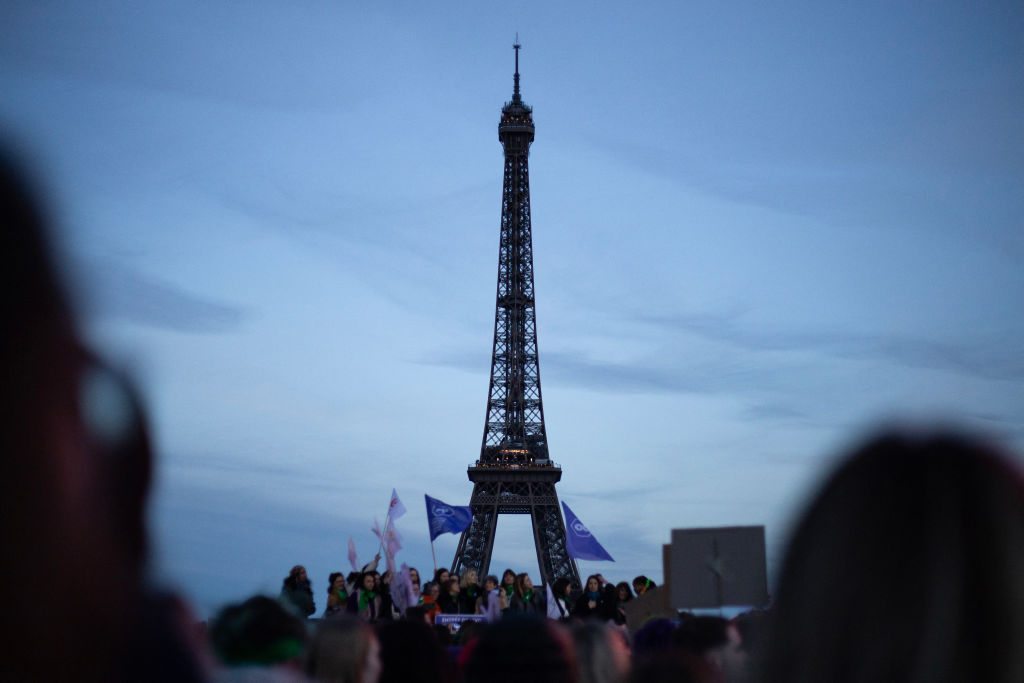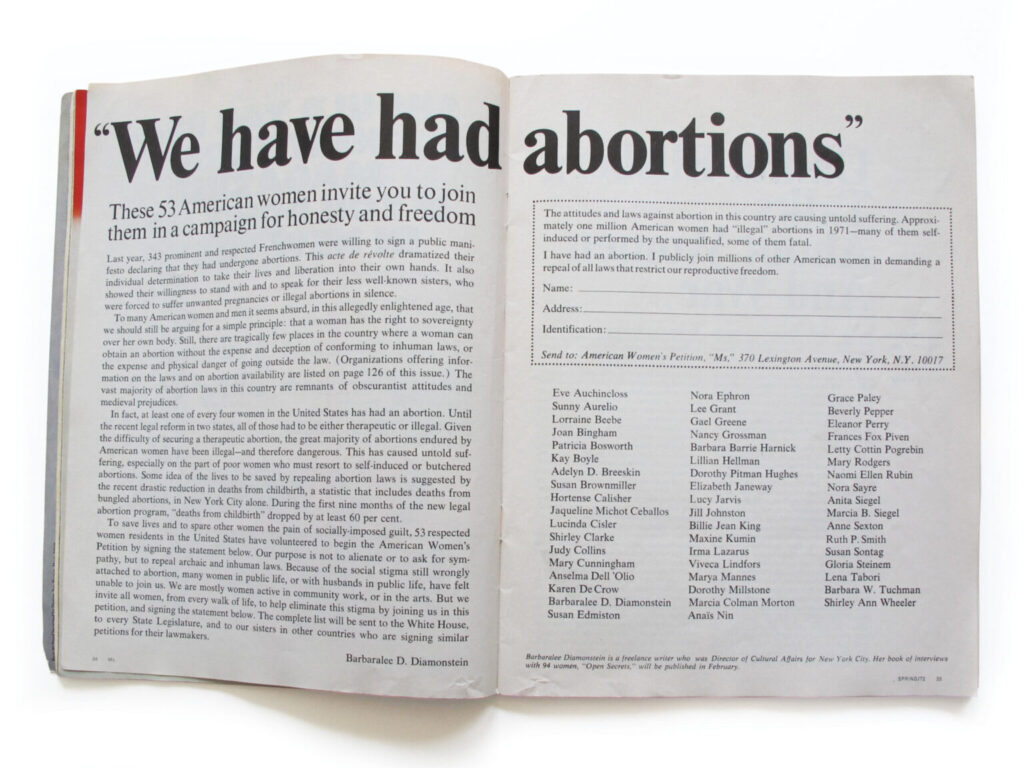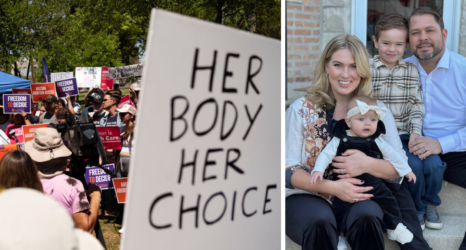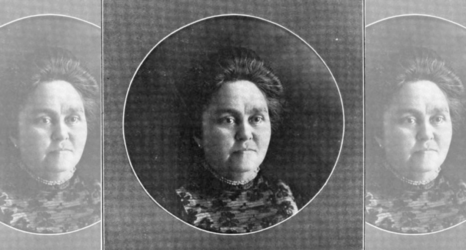The U.S. and France offer starkly different environments for women—but both countries share a strong feminist tradition. How do we explain their radically different abortion trajectories?

In 2023, seeking “to avoid a U.S.-like scenario for women in France, as hard-right groups are gaining ground,” President Emmanuel Macron promised a constitutional amendment affirming women’s right to abortion and to control over their own bodies. The amendment subsequently passed by a crushing majority of 780 to 72 votes and was inserted ceremoniously into the French Constitution on March 8, 2024, International Women’s Day.
In celebration, the Eiffel Tower was lit up with the message “My Body, My Choice.” This global first came approximately 50 years after the French Parliament first voted to decriminalize abortion with the passage of the Veil Law, named for feminist minister of health Simone Veil, who championed the reform.
Meanwhile in 2022, the Dobbs v. Jackson Women’s Health Supreme Court decision overturned the landmark 1973 Roe v. Wade that held abortion as a protected right under the United States Constitution. Reversing nearly 50 years of well-established precedent, the Dobbs Court insisted, based on a narrow and ahistorical textualist analysis, that Roe was an illegitimate “exercise of raw judicial power.” It accordingly returned legal authority over abortion to the states, including the power to ban it outright. Since, 14 states have banned abortion.
Abortion Rights in the U.S. and France
While the U.S. and France decisions demonstrate starkly different environments for women, both countries share a strong feminist tradition. During the 1960s, the call mounted in both countries for the decriminalization of abortion as part of the broader ensuing struggle for sexual and bodily autonomy.
France
In France, after women gained the right to vote in 1945, feminists mobilized to overturn a repressive 1920 law that criminalized both birth control and abortion, and eventually legalized contraception in 1967.
The social upheaval of 1968 further spurred women’s demands for sexual freedom and particularly the right to abortion.
In 1971, 343 women, mostly well-known public figures—writers, actors, artists, journalists, doctors and lawyers—published a manifesto in the widely circulated magazine Le Nouvel Observateur, broadcasting that they had undergone illegal abortions. Another publicly circulated manifesto signed by 252 doctors proclaimed women’s right to terminate pregnancies. Public meetings in favor of abortion as well as successful legal challenges to the 1920 law ultimately led to the passage of the Veil Law in 1975.
United States
In the United States, after an initial effort in the 1960s by professionals to liberalize the nation’s criminal abortion laws, feminists began demanding their full repeal on that grounds that this was an essential prerequisite to women’s “full human dignity and personhood.”
In 1970, marking the 50th anniversary of women’s suffrage, a broad array of women and some men across the country participated in the “Strike for Equality,” calling for, among other rights “free abortion on demand.” Feminists also began holding “speak-outs” in which women shared stories of their illegal abortions. Adding to this ferment, a new generation of activist lawyers successfully challenged criminal abortion laws in the lower courts which helped to the stage for the ultimately successful showdown before the Supreme Court.

Notably, however, the post-decriminalization trajectory of abortion rights moved along separate paths in the two countries. Accordingly, as decriminalization approached the 50-year mark, the respective reproductive ecosystems were quite distinctive.
Abortion as a ‘Necessary Evil’: Restrictions in France
In France, rooted in Simone Veil’s generally shared view among parliamentarians that abortion was a “necessary evil,” the 1975 Veil Law was actually fairly conservative in nature. Although it decriminalized abortion, it contained a range of restrictive requirements. These included psychological and social counseling which arguably aimed at discouraging women from choosing abortion, a parental consent requirement for minors, a 10-week gestational limit, and an eight-day waiting, or “cooling off” period. There were also strict limitations on reimbursement by Social Security.
Over the next several decades, Parliament gradually eliminated or modified these restrictions, and made abortion fully subsidized by France’s social security system.
While liberalization of the law certainly generated debate in the National Assembly, it did not meet with same degree of fierce anti-abortion pushback as was occurring in the United States, despite the fact that France had an active and violent anti-abortion movement, which was closely tied to the one in the U.S. And support for women’s right to abortion has only grown in recent years—in France, according to a 2021 poll, 93 percent of respondents said they supported abortion and 90 percent said that they favored a constitutional amendment enshrining the right to abortion.
Chipping Away at Roe
In the United States, in contrast, as soon as the Court announced its decision in Roe, anti-abortion activists mobilized to eviscerate it. Absolutists sought unsuccessfully to demolish it in one fell swoop by way of a human life amendment to the federal constitution, which would have effectively rendered Roe null and void.
In contrast, incrementalists sought to chip away at the decision through the enactment of restrictive measures aimed at limiting abortion access, starting with bans on Medicaid funding and parental involvement laws, with the eventual goal of getting a case before a changed Supreme Court.
Ultimately, although the Court’s 1992 decision in Planned Parenthood v. Casey affirmed what it referred to as Roe’s core holding, namely that abortion was a protected constitutional right, it nonetheless green-lighted the ability of states to enact laws “designed to encourage [women] to know that there are philosophic and social arguments of great weight that can be brought to bear in favor of continuing the pregnancy to full term.”
Accordingly, by the time Dobbs reached the Supreme Court, abortion access had been greatly limited, with a disproportionate impact on vulnerable and structurally marginalized populations.
Anti-Abortion Powers in the U.S. and France
So how do we explain the radically different trajectories on this critical dimension of women’s rights between two countries with strong feminist and anti-abortion movements that decriminalized abortion within a few years of one another?
There are likely a multitude of contributing factors. For example, France is a small and highly centralized country with more latitude in national policy making, while in the U.S., as we have seen, states have had the latitude to push back against Roe, ultimately chipping away at the scope of federal constitutional protection for the abortion right.
However, the most critical difference is likely religion and the concomitant role it has played—or not played—in shaping the political environment in each country. At the time of decriminalization, France was a strongly Catholic country, and there was considerable opposition to legalization. More recently, however, Catholicism has ceased to occupy a central place in French public life.
Reflecting this reality, opposition to abortion does not figure on the platform of any political party. Even the extreme right National Rally Party, many of whose representatives—including Marine Le Pen—voted to support the constitutional amendment.
The post-decriminalization picture was, of course, far different in the United States. Initially, the Catholic Church led the charge against abortion, and since the Republican Party was predominantly affiliated with mainline Protestants, it had not yet become the “pro-life” party. At the time, the white evangelical Protestant movement and its fervent belief in the sanctity of fetal life was gaining traction. In 1976, in an effort to attract social conservatives, the Republican Party incorporated an anti-abortion plank into its national platform.
With the rise of the New Right, (also known as the Christian New Right), as Carol Mason writes in her book Killing for Life: The Apocalyptic Narrative of Pro-Life Politics, “pro-life politics went from defense to offense” and “right-wing politicians and evangelicals used abortion as the issue around which to mobilize [voters].”
In 2020, 74 percent of evangelical Protestants in the US, who account for one quarter of the country’s population, believed that abortion should be illegal, according to Pew Research Center.

Fourteen states have banned abortion since Dobbs, and many others, mainly in the South and Midwest, have enacted gestational limits and a host of restrictive measures. The Supreme Court will soon rule in a case that challenges liberalized access to the abortion drug mifepristone.
In this context, are there lessons to be learned from the French experience? And with the U.S. being only one of four countries in the world to have increased restrictions on abortion in the past 30 years—the others being El Salvador, Nicaragua and Poland—while more than 60 countries and territories liberalized their laws, we need to ask what we can learn from the wider global feminist community.
Up next:
U.S. democracy is at a dangerous inflection point—from the demise of abortion rights, to a lack of pay equity and parental leave, to skyrocketing maternal mortality, and attacks on trans health. Left unchecked, these crises will lead to wider gaps in political participation and representation. For 50 years, Ms. has been forging feminist journalism—reporting, rebelling and truth-telling from the front-lines, championing the Equal Rights Amendment, and centering the stories of those most impacted. With all that’s at stake for equality, we are redoubling our commitment for the next 50 years. In turn, we need your help, Support Ms. today with a donation—any amount that is meaningful to you. For as little as $5 each month, you’ll receive the print magazine along with our e-newsletters, action alerts, and invitations to Ms. Studios events and podcasts. We are grateful for your loyalty and ferocity.





